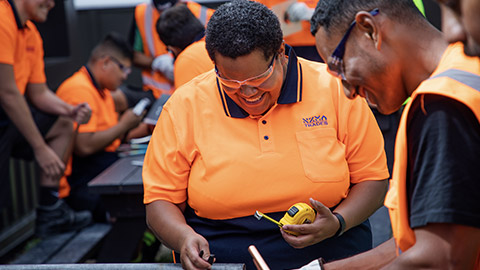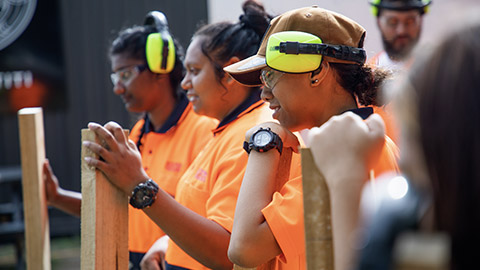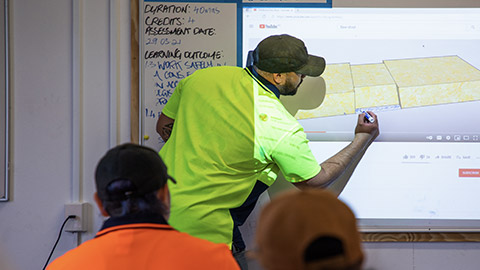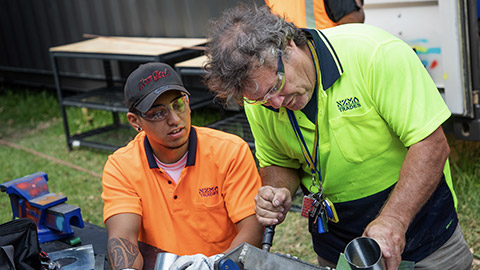Stages in Training
Effective training begins well before the instructor delivers an individual training session and continues after that training session is complete.
There are five stages to the training process, each with its strategies and techniques. These stages build on each other, guiding trainers through development, delivery, and assessment.
Type of Skills in the Construction Industry
Now that you're ready to implement some training activities. How do you decide what skill type to train?
In the construction industry, the skills required can be categorised into two broad categories:
- General skills
- Job-specific skills
General Skills
General skills are the type of skills that are transferable and applicable across the construction industry, even if the individual changes career fields. Examples of general skills include:
- Communication: Effectively communicating with team members, clients, and suppliers.
- Time Management: Managing time efficiently to meet project deadlines.
- Problem-solving: Identifying and resolving issues that arise during construction projects.
- Teamwork: Collaborating with others to achieve project goals.
- Safety Awareness: Following safety protocols to ensure a safe working environment.
Job-Specific Skills
Job-specific skills in construction refer to the unique abilities and knowledge required for tasks like carpentry, plumbing, or operating machinery on construction sites.
These skills are essential for completing specific jobs effectively and safely in the construction industry. A single tradesperson is not likely to have all of the skills mentioned below and would typically specialise in a particular trade skill. Examples of job-specific skills include:
- Carpentry: Framing, installing windows and doors, and finishing work.
- Electrical Work: Installing wiring, switches, and electrical fixtures.
- Plumbing: Installing and connecting plumbing systems, fixtures, and appliances.
- Masonry: Laying bricks, blocks, or stones to construct walls or other structures.
- Concrete Work: Pouring and finishing concrete for foundations, slabs, or sidewalks.
Both types of skills are important for success in the building project, with general skills serving as a foundation upon which job-specific skills can be built to meet the company's unique needs and goals.

Employees who are enthusiastic about learning and growing play a significant role in the company's success.
By providing ongoing training and development opportunities, employees are more likely to feel valued, engaged, and motivated. Conversely, workers who feel neglected or uncertain about their roles may experience lower morale, resulting in absenteeism, conflicts, or the search for other job opportunities. As a result, promoting a culture of on-site training is essential for project success and staff professional development.
Every construction site is unique, but there are several effective strategies to boost motivation and engagement in training.
- communicating the benefits
- making training relevant to the job
- offering incentives for participation
- allowing flexibility in training schedules
- promoting a culture of continuous learning
- showing ongoing leadership support
- gathering feedback regularly.
Retraining
Team members may find that their skills no longer match the changing demands of their roles over time. To stay relevant, employees often benefit from refresher courses to either refresh forgotten knowledge or acquire updated skills to replace outdated practices.
These workers depend on the company to provide current knowledge and skills, reigniting their enthusiasm for their tasks.
The need for skill retention becomes especially apparent when technological advancements bring changes in equipment, methodologies, or tools.
Sources of Motivation
A prominent figure in education from Hawaii University, S. Lieb, shared the following quote;
The best way to motivate adult learners is to emphasise the value to their goals of what they are learning.S. Lieb
Adults prioritise training directly applied to real-world roles and responsibilities, driven by the question, “What’s in it for me?"
This question significantly impacts the success of adult learning, influencing the direction, intensity, persistence, and quality of learning behaviours. Motivation in adult learning can be categorised into:
- extrinsic (external)
- intrinsic (internal).
External motivators may include salary increases, higher status, job titles and perks, incentive pay, academic credit, or promotions.
Intrinsic or internal motivators may include things such as job satisfaction, personal growth, and improved quality of life.
Internalising motivation is when the learner wants to learn or achieve something that comes from within themselves rather than relying on external rewards like money or promotions.
It's important to find satisfaction and enjoyment in doing things you genuinely care about rather than just doing it to gain something from it. Trainers and mentors can help by creating an environment that makes you feel empowered, capable, and connected to others so that you remain motivated and continue to grow and learn.
In addition to the external and internal sources of motivation, Lieb (1991) outlines six sources of motivation that can guide effective teaching.
- Social relationships: to make new friends, to meet a need for associations and friendships.
- External expectations: to comply with instructions from someone else; to fulfil the expectations or recommendations of someone with formal authority.
- Social welfare: to improve the ability to serve humanity, prepare for service to the community, and improve the ability to participate in community work.
- Personal advancement: to achieve higher status in a job, secure professional advancement, and stay abreast of competitors.
- Escape or stimulation: to relieve boredom, provide a break in the routine of home or work, and provide a contrast to other exacting details of life.
- Cognitive interest: to learn for the sake of learning, seek knowledge for its own sake, and to satisfy an inquiring mind.

Learning styles relate to the characteristic strengths and preferences in how learners process information.
When people engage in problem-solving, product creation, or social interactions, their thoughts and emotions vary from person to person.
Everyone's learning style is influenced by many factors like personality, background, and culture. That's why there are different models to help understand and adapt to these styles. While some people question these theories, most agree that everyone learns differently.
So, using tools to gauge learning styles in group sessions can help people better understand themselves, spark discussions about how they learn best, and create a more inclusive learning environment that celebrates everyone's differences.
The VARK Model
Fleming and Mills’ VARK model is one of the most popular methods for finding out learners' learning styles.
In this model, learners are identified by whether they have a preference for certain types of learning when it comes to training or teaching; these are:
- visual learning (pictures, movies, diagrams)
- auditory learning (music, discussion, someone in front of class talking)
- reading and writing (making lists, reading manuals, taking notes)
- or kinaesthetic learning (movement, experiments, hands-on activities).
Most facilitators in their respective fields agree that while a learner may be strong in one area, most learners have aspects of all of them.
With the introduction of technology, there are advocates to add a new category to the list to incorporate the learning style of (T) for technology.
Knowing how people learn can be helpful for making training more engaging and inclusive, but it's just one part of good teaching. When planning lessons, it's also important to think about things like what interests people, what they already know, and where they come from. That way, you can create a learning environment that works for everyone.
Explore
What is your learning style?
https://vark-learn.com/the-vark-questionnaire/
After carrying out the questionnaire to find your style, further information on these learning styles can be found.
You might hear the word training and development being used interchangeably. So, are they both the same? Not quite.
Here are the main differences:
- Training is helping your team get better at their jobs by teaching them new skills and knowledge. Training typically focuses on building specific skills or knowledge related to job tasks, such as operating machinery or following safety protocols.
- Development is helping your team grow as individuals by uncovering their talents and potential through tailored learning opportunities. On the other hand, development involves broader growth opportunities that may include advancing into leadership roles or acquiring additional certifications.
While training is often more hands-on and task-oriented, development may involve mentoring, coaching, or pursuing higher education to enhance career prospects in the construction industry.
The following table outlines the differences in more detail.
| Training | Development |
|---|---|
| Mostly short-term with a concrete goal. | A long-term activity with goals that are open-ended and ongoing. |
| Focuses on the role. | Focuses on the person. |
| Aims at a specific job or role requirement. | More conceptual and focuses on the overall progression of the individuals. |
| Revolves around the immediate or present need. | Activities are futuristic. |
| Enhances the knowledge and skills for a particular job or role. | Focuses on career building and progression. |
| Group-focused, where more than one individual participates in organised group events such as workshops, classes or seminars. | It tends to be more of a personalised experience, which is catered to based on the individual's development plan. |
| The organisation takes the responsibility of training. | Individuals are held responsible for creating and owning their development plans and activities. |
Now that you know the stages of training, what motivates learners and how different people learn, let's look at a very important piece of the big picture – how to decide whether training is actually needed and, if so, what is required.
Training Needs Assessment
A training assessment is a comprehensive evaluation aimed at pinpointing the overall training requirements within an organisation.
During the assessment phase, experienced team members take charge. They gather information using surveys, interviews, and feedback sessions before or after training. This data doesn't usually cover how to meet or carry out those needs.
Training Needs Analysis
After the assessment, the analysis phase is conducted, which is more in-depth and specific in its approach. The analysis involves a closer examination of the training needs identified during the assessment.
During this stage, we analyse what training and development our workforce needs across different roles, professions, and contractor roles. The aim is to help them do their jobs well and grow in their careers while staying safe and efficient. This analysis looks at the skills, knowledge, and behaviours our staff need and finds effective ways to recognise and develop them.
The outcome of this analysis should be a solid plan for learning and development. This plan should be based on the needs we've identified and should fit closely with the goals of our organisation, our teams, and each individual.
Training Needs Analysis Process
The training needs analysis process is about gathering information to:
- identify gaps between job knowledge and skills required now or for future employment needs
- the current knowledge and skills of an employee or group of employees.
It starts with collecting information against the four levels of needs (legislation, organisation, job and individual needs).
When collecting information, it's important to ensure that the methods used are appropriate for the specific goals of the analysis. Combining multiple data collection methods, such as surveys, interviews, and observation, is also important, which can provide a more comprehensive and accurate understanding of the job's requirements and responsibilities.
The diagram below identifies and classifies needs or gaps into learning or non-learning opportunities related to the information collected.
Diagram adapted from Australian Construction Association.
Post analysis process
Once an analysis has been carried out or conducted, the next steps typically involve:
- Interpreting the data collected thoroughly (review any identified patterns, trends, or issues).
- Followed by identifying or determining the organisation's specific needs, gaps, or opportunities for improvement.
You need to define clear and measurable objectives or goals to address the identified training needs. These objectives should guide the required training or development process. Remember the specific actions and sequence of steps may vary depending on the organisation, the nature of the company analysis, and the goals of the training or development initiatives.
Job and Legislative Analysis
The primary purpose of job analysis is to understand the various components of a job, including its duties, responsibilities, qualifications, and requirements.
This information is crucial for several management functions on the construction site, such as adhering to government legislation and building standards.
So, a job analysis would focus on understanding and documenting the details of a specific job within an organisation while, in turn, covering the legislative components involved, including construction laws and regulations, to be in line with company policy objectives.
Within most construction sites, this evaluation is critical in making informed decisions to ensure compliance with all relevant laws and regulations.
Job and task flow example
Diagram adapted from Australian Construction Association.
This analysis of job and task would relate to specific jobs within the site and use information about the job to develop a standard of performance, which would identify the necessary licenses, certificates and regulatory requirements. Also, it covers knowledge, skills and characteristics to achieve the desired performance standards.
This would create a level of training necessary for certain jobs which together make up an organisation portfolio.
In summary, to help determine the required training needs for a particular job, a job analysis could be conducted to document the requirements of a particular job in an area and the required work performance.
Job analysis template can be downloaded here.
Task Analysis
The purpose of a task analysis would be to document the skills, knowledge, standard performance and legislative requirements required to complete a certain task safely and to standard.

Numerous approaches are available for instructing and developing workers' skills in the construction industry.
Companies can select a combination of training techniques to train workers depending on which method suits the content material required and what works best for the learners.
Training Method Ideas
- Computer-based learning comprises any training that can take place on the computer. The significant advantage of technology-based learning is its flexibility and adaptability to learner scalability.
- Roleplaying. This generally involves a learner and a trainer, where each can act out various potential worksite scenarios.
- On-the-job is one of the most typical types of training techniques. This hands-on training concentrates primarily on the practical skills essential for the job, with observation and feedback.
- Videos can make complex material more engaging, interactive, and demonstrative.
- Classroom-style training. This is where a trainer or the teacher prepares and leads the experience, generally using visual elements.
- Case studies may be the most effective training technique for improving analytical and problem-solving aptitudes as they outline potential scenarios that could happen on-site.
- Group training may be useful when a company or trainer must share data with a large group of workers. It can be an efficient means to ensure that all workers receive a consistent message.
Remember, providing written instructions after training is a good practice to enhance the effectiveness, consistency, and accessibility of any training session. It helps reinforce learning, clarify, and ensure that staff or learners have a reliable reference to follow. Also don’t forget to communicate how frequently the training will be conducted or required if needed.
Use your company handbook, current worker knowledge base, internet resources, and other industry-relevant sources to define your training objectives and to use as a guide.
Reading
The following article outlines and gives you some useful techniques on How to Train Construction Workers on New Technology.
When creating a training programme for your team, it’s crucial to consider and assess their prior training experiences. The following list of questions serves as an initial guide.
- What is the history of training within the organisation?
- What needs are being addressed by the training?
- Are there any recent process or procedure changes?
- What are the legislative and regulatory requirements that must be adhered to?
- What resources are available to conduct the training?
- Who needs to be trained, how often and what is the priority?
- Who can serve as subject matter experts?
- How will the training be conducted?
The best way to maximise learning across multiple construction site areas is by including the participants’ leaders. Professional training often fails because the participant learns new skills or ideas that their leader isn’t exposed to, so therefore doesn’t actively support or understand.
Example - Training Plan
Date: 27 May
Organisation goal: Revision on work safety at heights
Analysis outcome: Training on the fall arrest system
Participants: All team members, including scaffolders and roofers
How this will be evaluated: Team members will demonstrate competency with the relevant height safety equipment.
Learning and Development Activities:
- Harness checks
- Safety line checks
- Lanyard check including fixed, adjustable and shock-absorbing
- Revise anchor points
Resources required:
- Whiteboard
- Pens
- A3 paper
- Internet access
- Demo harness
- Safety lines
- Lanyards
- Feedback forms
Internal Training
Internal or on-site training provides training that is tailored to the unique requirements of the company and its workers.
Using internal training programmes in construction companies is a win-win situation. It saves staff time by allowing them to improve their skills without leaving the workplace. Plus, it's cost-effective because training multiple employees simultaneously reduces expenses compared to sending each to external programs.
In larger construction firms, customising training content is the way to go. This way, seasoned employees get targeted training that tackles the company's unique goals and challenges head-on. It's all about aligning training with what the company wants to achieve.
With internal training, project managers can:
- maintain control over the timing and duration of these training sessions
- schedule the training in a way that does not disrupt regular working hours
- ensure workers do not fall behind in their usual tasks
- foster team building through group activity
- encourage collaboration.
External Training
External training provides the opportunity to tap into the knowledge and expertise of specialists brought into the workplace.
External training rocks because it:
- provides quick access to the latest knowledge and certifications of up-to-date practices
- is a smart investment, as external programmes offer tailored instruction from experts
- saves time by bringing in specialised guidance and support, sparing you from the trial-and-error of trying to learn everything independently from seasoned staff members.
Let's put it all together!
The following is a Documentation Tool activity where you can plan and implement a training activity.

In te ao Māori, ako means both to teach and to learn; it acknowledges that everyone has unique knowledge and experiences that they bring to a learning experience.
Everyone has the ability to be both a kaiako (teacher) and ākonga (learner). The concept of ako describes a teaching and learning relationship where the educator is also learning from the student. Ako acknowledges how new knowledge and understanding can grow from shared learning experiences.
Ako is grounded in the idea of reciprocity. Reciprocity means that things rely on each other to work in harmony. In Ako, the students rely on the teacher to guide and instruct, and the teacher learns from the students in the same interaction. In a reciprocal learning relationship, teachers are not expected to know everything. Ako suggests that each member of the learning or workplace setting brings knowledge with them from which all are able to learn.
The principle of ako affirms the value of the pair (two people) and group learning approaches in which students interact with their peers, teachers, tasks, and resources. Embracing the principle of Ako enables trainers and supervisors to build a supportive and inclusive learning community where each person feels their contribution is valued and can participate to their full potential.
Learners and their whānau
Ako also states that the learner (team member) and their whānau cannot be separated.
Considerations around training events' timing and expected commitment can determine the success or failure of the training activity. The following are other ideas on how whānau can be involved and actively participate in the team member's training journey.
-
Performing karakia or prayers. Karakia are prayers that serve as an acknowledgement of a higher power. It is usually performed before and at the end of meetings or official proceedings. A karakia does not need to follow a specific religious practice and allows people of all faiths to join and set their intention for their journey to come.
-
Family-friendly scheduling. To the best of your ability, schedule any training sessions during times that are during work hours or family-friendly hours, eg. not first thing in the morning or in the evening.
-
Invitation to attend company-sponsored social events or gatherings, allowing them to network with other construction professionals and better understand the industry's culture and expectations.
-
Conducting a workshop focused on construction safety. During the session, whānau can learn about the importance of safety protocols and procedures on construction sites and how to identify potential hazards and mitigate risks.
-
Organising a site visit for the learner's family or whānau to a construction project involving the learner. During the visit, they can observe the construction process, interact with the learner's colleagues and supervisors, and better understand the learner's work environment. This hands-on experience can help the family members appreciate the learner's contributions to the construction project and understand the challenges and opportunities in the construction industry.
-
Organising a career guidance session for the learner's family or whānau members. This session could provide insights into the construction industry, career opportunities available, and the training pathways necessary to pursue a career in construction. By involving family members in understanding the learner's career aspirations and the support needed to achieve them, the learner receives encouragement and support from their whānau, which can positively impact their motivation and commitment to training activities.
Practice
Let's embrace te ao Māori (the Māori worldview) and te reo Māori (the Māori language) to honour the interconnectedness of all living and non-living things.
What can you do to incorporate more of these examples into your training practice sessions?
Numerous surveys have been conducted and examined to understand the perspectives of employees and employers in New Zealand regarding obstacles to workplace education and training. Many of these studies have shown that both parties identified limited time and financial constraints as hindrances to pursuing education and training opportunities at work.
As an on-site supervisor, you play a key role in ensuring that your team receives effective training and support.
Therefore, you play a pivotal role in identifying and addressing these barriers. The best part is, if you can do that, it can lead to awesome benefits like increased safety, compliance, quality, productivity, and overall project success.
Reading
This article from Employment New Zealand outlines some key principles and guidelines managers and supervisors can follow to achieve training success within their teams.
